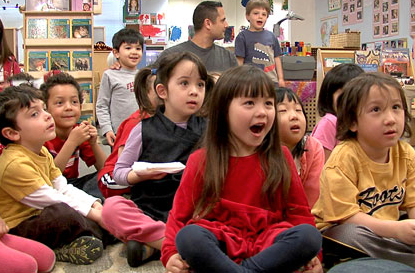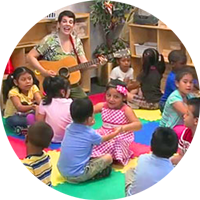Today is Special Education Day
December 2 is Special Education Day, commemorating the 1975 passage of the Individuals with Disabilities Education Act (IDEA). At Music Together, we celebrate this landmark legislation, the first U.S. federal law ensuring that all children, including those with disabilities, have access to public education.
Research has shown that music in early learning settings supports the social and academic outcomes of children of all abilities. Music is also one of the content areas protected under the IDEA. We work with teachers around the world to help them learn how to use music to engage each child at whatever level they’re currently learning. According to our Manager of Special Needs Services, board-certified music therapist Carol Ann Blank, MMT, “When we infuse early childhood learning experiences with music, we’re parlaying the motivating power of music to enhance learning processes.”
To most effectively use music to reach all types of learners in an inclusive classroom, we encourage teachers to try the following strategies:
- Choose selections that vary in tone, meter, rhythm, function, and genre. Although the first inclination might be to use contemporary songs or movie soundtracks, a better approach is to change the words of children’s songs to fit the lesson. For example, “The Wheels on the Bus” can easily become “The Wings on a Plane,” if that better suits your lesson plan.
- Ensure regular exposure to music by making it part of your daily classroom routine. Include it as part of circle and transition times, stock a music center with instruments and recorded music, and establish musical rituals for daily activities.
- Be confident in your ability to share the joy of music! Even if you don’t have stellar musical skills, you can still teach young children to love music. With little ones, there’s no right or wrong way to sing or move; they just want you singing and moving with them. If you would like more support, you might reach out to musicians in your community to ask for advice or lessons on new ways to bring music and rhythm into the classroom.
- Partner with the parents of the children in your classroom. Go beyond sending a sheet home telling parents that their children danced during movement time. Instead, be explicit about what – and how – music is used. Be specific with parents, telling them what songs their child liked and even providing links for them to download the songs to sing along with at home. In turn, ask parents to send in songs their children particularly enjoy.
- Establish benchmarks. While children with special needs may not develop music competence in their first five years of life, it’s important to see if they’re vocalizing, finishing songs, and moving above and below the waist in time with the music. Learn if they want to do it again, or if they’ll do it on their own. That last point is particularly important for children with special needs. These little learners may be overwhelmed by the kind of music experiences other children are enjoying. But if they exhibit musical behavior outside of the dedicated classroom music time, you’ll know you’ve created an enriching environment.
In an inclusive classroom, children can have shared experiences, which promotes a culture of connection and socialization among learners of all abilities. In short, music brings us all together.





